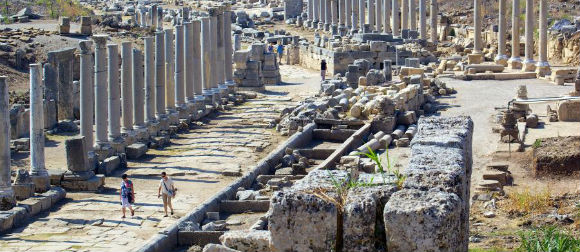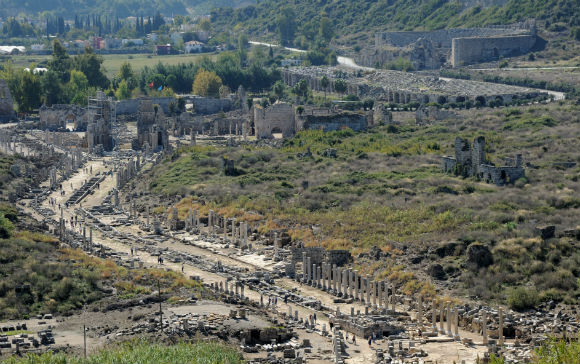The most impressive ruins of the Pamphylian coast are at Perge, at about 15 km east of Antalya. Perge was originally founded by the Hittites around 1500 BC. and was known as Parha. It was a successful trading centre near the Aksu (ancient Kestros or Cestrus) river when Alexander the Great arrived in 333 BC. He was welcomed in by the inhabitants and used Perge as base for his Anatolian campaigns. Alexander was followed by the Seleucids under whom the city prospered and Perge’s most celebrated inhabitant, the mathematician Apollonius from Perge lived and worked. Apollonius was a pupil of Archimedes and wrote a series of eight books on geometry. In 188 BC Perge became part of the Roman Empire during which the city flourished. Most of the surviving buildings date from this period.In 46 AD St. Paul started his journey in Perge (biblical Perga) and preached his first sermon here. Perge gradually declined during the Byzantine period, as the Aksu river silted, but remained inhabited until Selçuk times after which it became abandoned.
A visit to Perge starts by entering the archeological site through the Roman Gate, built during the reign of Septimius Severus (193-211 AD). Proceeding through the gate, to the right is the Agora or market place. This structure of 75 x 75 m dates back from the 2nd century AD. The center courtyard and shops were surrounded by a wide stoa, a covered walkway. The floor of the stoa and shops was made of colored mosaics. The agora was not only the centre of Perge’s trade, but was also a place for meetings as well as a forum for political, social, and philosophical discussions. The next building is the Hellenistic city gate that dates back to the 3rd century BC. This is certainly the most imposing building of the city and was cleverly designed to protect the city with its twin towers and its horseshoe-shaped courtyard at the back. It is thought that the towers had three floors and were crowned by a conical roof. In the year 121 AD, the horseshoe-shaped courtyard was rededesigned as a courtyard of honor. Behind the courtyard stood a triple arch. Around the arch there are about dozen inscriptions connected with Plancia Magna who lived in the 2nd century AD. She was the daughter of the governor, a priestess of Artemis Pergaia (Diana) and a benefactress to the city. Plancia Magna had the arch decorated with the statues of the emperors and their relatives.
After passing through the Hellenistic Gate and courtyard, one enters a broad, marble-paved double-colonnaded street measuring 300 meters in length that extends from the main gate to the acropolis. The street is 20 m wide and is divided in two by a 2 meter wide water channel running down the middle. At the end of the colonnaded street is the Nymphaeum, a triumphal fountain from where a stream flowed down into the water channel. The nymphaeum or nymphaion is an ornamental semicircular structure and dates from the reign of Emperor Hadrian (130-150 AD). A statue of a river god Kestros was located in the center of this huge fountain. Behind the nymphaeum is the acropolis with some remains of the Byzantine period. To the west of the nymphaeum are the remains of a palaestra dating from 50 AD and dedicated to the Emperor Cladius (41-54 AD).
Returning back to the entrance, there are the excavated Roman baths located southwest to the agora. Out of the site proper, is the horsehsoe-shaped stadium, the largest in Asia Minor, measuring 234 m by 34 m. The stadium had a seating capacity of 12,000 people supported by massive barrel-vaulted constructions. Just beyond the site entrance is also the theatre, which is of the Greco-Roman type and could seat 15,000 people. Unfortunately, it is for some time under reconstruction and unfortunately closed to visitors.
Perge,



The Perge ruins have some of the best-preserved baths we've seen in Turkey and Italy. We also loved seeing the many terra-cotta pipes that were used to carry fresh water to houses (so crazy!! they could figure out plumbing in 1AD but most of Northern Europe couldn't figure that out until about 1700 years later!). The stadium is also quite…
Just a fantastic site now being restored. Best with a guide who can explain the history. Our Antalya man Hakan of Eros Travel, who arranges our holiday provided an excellent guide who spoke perfect English and showed us the various features of this largely Roman site.
just to get the feel for the layout of a roman city the ruins are pretty well preserved quite interesting
This was one of the most beautiful and naturally unspoilt places places I have ever been to. We visited this as a part of our guided tour to Aspendos and the Duden waterfalls and what a sight to behold with the old Roman and Corinthian ruins dating back thousands of years. The ruins have been preserved so well that the…
very interesting place. We had a terrific guide who was passionate about his subject. Shows that there was civilisation before the romans.
Like most of the major archaeological sites in Turkey, Perge is somewhat hidden away but easy to access. The heat is intensive – there is not much cover and no opportunity for drinks or snacks once you enter the site itself. The site is massive with huge amounts of remains. You don't have to visualise what it would have looked…
the guide was very informative and brought it to life his name is ata and we enjoyed it very much,take plenty to drink as it gets very hot
This well preserved site was amazing. So much to see and take in. Not only the city but also the stadium and amphitheatre outside. My history loving son was awe struck by the sights. Beware the temperature can get very hot. Take plenty of water and sensible shoes as the terrain is quite rough.
The walking areas are not for disabled people. The restauration work was impressive and there much to do in the future. Entrance 6 TL
As mentioned by others, one can enjoy this site without the crowds found elsewhere, such as Ephesus. The baths, fourm and the "divded" main road gives one a sense of how prosperus this city was. All the beautiful artwork can be seen at the Anatolya Archeological Museum. Need to see both to truly appreciate.